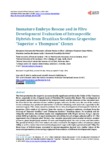Por favor, use este identificador para citar o enlazar este ítem:
http://www.alice.cnptia.embrapa.br/alice/handle/doc/988687Registro completo de metadatos
| Campo DC | Valor | Lengua/Idioma |
|---|---|---|
| dc.contributor.author | MENEZES, E. F. de | pt_BR |
| dc.contributor.author | SILVA, E. M. e | pt_BR |
| dc.contributor.author | MELO, A. M. Y. | pt_BR |
| dc.contributor.author | LEAO, P. C. de S. | pt_BR |
| dc.contributor.author | MELO, N. F. de | pt_BR |
| dc.date.accessioned | 2014-06-20T11:11:11Z | pt_BR |
| dc.date.available | 2014-06-20T11:11:11Z | pt_BR |
| dc.date.created | 2014-06-20 | pt_BR |
| dc.date.issued | 2014 | pt_BR |
| dc.identifier.citation | American Journal of Plant Sciences, Irvine, v. 5, p. 1956-1960, 2014. | pt_BR |
| dc.identifier.uri | http://www.alice.cnptia.embrapa.br/alice/handle/doc/988687 | pt_BR |
| dc.description | The fruit production for export is an economically significant activity in the Valley of São Francisco River, especially in the irrigated lands of Petrolina-PE/Juazeiro-BA, Brazil. The development of new genetic material most suitable to the tropical climate and the demands of the consumer market have led to the selection of new seedless grapes cultivars. In this case, the use of the embryo rescue technique has produced satisfactory results for obtaining such materials, especially in the semiarid region. This study aimed to evaluate the in vitro development of intraspecific hybrids of grapevine (Vitis vinifera L.), derived from the rescue of immature embryos resultant from the crossing of Superior Seedless and Thompson Seedless Brazilian clones. To establish and develop the cultivation, the culture media was supplemented with 30 g/L sucrose, 0.1 g/L myo-inositol, 0.002 g/L glycine, 0.1 mg/L indoleacetic acid (IAA), 6.5 g/L of agar, adjusted pH to 5.7. The experiment was evaluated after 90 days. The variables measured were: number of nodes, number of leaves, plant height (cm), number of roots and length (cm) of the root system and internodes. The period of 60 days of in vitro culture of ovules resulted in the highest values of embryos (about 50%), as well as better characterized developmental stages with higher germination (47.3%). The three types of hybrid grapes evaluated in micropropagation showed very similar values of the measured parameters, even having originated from embryos of different developmental stages. | pt_BR |
| dc.language.iso | eng | eng |
| dc.rights | openAccess | eng |
| dc.subject | Melhoramento genético | pt_BR |
| dc.subject | Uva sem semente | pt_BR |
| dc.subject | Cultivo in vitro | pt_BR |
| dc.title | Immature embryo rescue and in vitro development evaluation of intraspecific hybrids from Brazilian seedless grapevine Superior × Thompson clones. | pt_BR |
| dc.type | Artigo de periódico | pt_BR |
| dc.date.updated | 2014-06-20T11:11:11Z | pt_BR |
| dc.subject.thesagro | Uva | pt_BR |
| dc.subject.thesagro | Genótipo | pt_BR |
| dc.subject.thesagro | Vitis Vinifera | pt_BR |
| dc.subject.nalthesaurus | Grapes | pt_BR |
| riaa.ainfo.id | 988687 | pt_BR |
| riaa.ainfo.lastupdate | 2014-06-20 | pt_BR |
| dc.contributor.institution | EIRYANNE FONSECA DE MENEZES; ELIENE MATOS E SILVA; ADRIANA MAYUMI YANO-MELO, UNIVASF; PATRICIA COELHO DE SOUZA LEAO, CPATSA; NATONIEL FRANKLIN DE MELO, CPATSA. | pt_BR |
| Aparece en las colecciones: | Artigo em periódico indexado (CPATSA)  | |
Ficheros en este ítem:
| Fichero | Descripción | Tamaño | Formato | |
|---|---|---|---|---|
| Natoniel2014.pdf | 951,45 kB | Adobe PDF |  Visualizar/Abrir |









